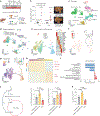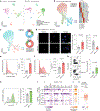Fatty acid binding protein 5 suppression attenuates obesity-induced hepatocellular carcinoma by promoting ferroptosis and intratumoral immune rewiring
- PMID: 38664583
- PMCID: PMC12355809
- DOI: 10.1038/s42255-024-01019-6
Fatty acid binding protein 5 suppression attenuates obesity-induced hepatocellular carcinoma by promoting ferroptosis and intratumoral immune rewiring
Abstract
Due to the rise in overnutrition, the incidence of obesity-induced hepatocellular carcinoma (HCC) will continue to escalate; however, our understanding of the obesity to HCC developmental axis is limited. We constructed a single-cell atlas to interrogate the dynamic transcriptomic changes during hepatocarcinogenesis in mice. Here we identify fatty acid binding protein 5 (FABP5) as a driver of obesity-induced HCC. Analysis of transformed cells reveals that FABP5 inhibition and silencing predispose cancer cells to lipid peroxidation and ferroptosis-induced cell death. Pharmacological inhibition and genetic ablation of FABP5 ameliorates the HCC burden in male mice, corresponding to enhanced ferroptosis in the tumour. Moreover, FABP5 inhibition induces a pro-inflammatory tumour microenvironment characterized by tumour-associated macrophages with increased expression of the co-stimulatory molecules CD80 and CD86 and increased CD8+ T cell activation. Our work unravels the dual functional role of FABP5 in diet-induced HCC, inducing the transformation of hepatocytes and an immunosuppressive phenotype of tumour-associated macrophages and illustrates FABP5 inhibition as a potential therapeutic approach.
© 2024. The Author(s), under exclusive licence to Springer Nature Limited.
Conflict of interest statement
I.O. and M.K. declare financial support from Artelo Biosciences. I.O. and M.K. have patents issued to the Research Foundation of the State University of New York. The other authors declare no competing interests.
Figures


















Similar articles
-
In vivo CRISPR screening identifies POU3F3 as a novel regulator of ferroptosis resistance in hepatocellular carcinoma via retinoic acid signaling.Cell Commun Signal. 2025 Jul 10;23(1):329. doi: 10.1186/s12964-025-02285-x. Cell Commun Signal. 2025. PMID: 40634958 Free PMC article.
-
FABP5+ lipid-loaded macrophages process tumour-derived unsaturated fatty acid signal to suppress T-cell antitumour immunity.J Hepatol. 2025 Apr;82(4):676-689. doi: 10.1016/j.jhep.2024.09.029. Epub 2024 Sep 30. J Hepatol. 2025. PMID: 39357545
-
A Conserved FABP5high Macrophage Subset Promotes Fibrosis and Carcinogenesis in Advanced Liver Disease.Liver Int. 2025 Sep;45(9):e70262. doi: 10.1111/liv.70262. Liver Int. 2025. PMID: 40874813 Free PMC article.
-
Role of ferroptosis in hepatocellular carcinoma.J Cancer Res Clin Oncol. 2018 Dec;144(12):2329-2337. doi: 10.1007/s00432-018-2740-3. Epub 2018 Aug 22. J Cancer Res Clin Oncol. 2018. PMID: 30167889 Free PMC article. Review.
-
Nonalcoholic fatty liver disease and hepatocellular carcinoma.Metabolism. 2016 Aug;65(8):1151-60. doi: 10.1016/j.metabol.2016.01.010. Epub 2016 Jan 23. Metabolism. 2016. PMID: 26907206
Cited by
-
Ferroptosis of T cell in inflammation and tumour immunity.Clin Transl Med. 2025 Mar;15(3):e70253. doi: 10.1002/ctm2.70253. Clin Transl Med. 2025. PMID: 40045458 Free PMC article. Review.
-
NOX1 inhibition sensitizes HCC cells to sorafenib and radiotherapy by modulating ROS-mediated programmed cell death.Acta Pharmacol Sin. 2025 Aug 7. doi: 10.1038/s41401-025-01623-6. Online ahead of print. Acta Pharmacol Sin. 2025. PMID: 40775534
-
Polarization of Tumor Cells and Tumor-Associated Macrophages: Molecular Mechanisms and Therapeutic Targets.MedComm (2020). 2025 Sep 1;6(9):e70372. doi: 10.1002/mco2.70372. eCollection 2025 Sep. MedComm (2020). 2025. PMID: 40904700 Free PMC article. Review.
-
Targeting cell death mechanisms: the potential of autophagy and ferroptosis in hepatocellular carcinoma therapy.Front Immunol. 2024 Sep 9;15:1450487. doi: 10.3389/fimmu.2024.1450487. eCollection 2024. Front Immunol. 2024. PMID: 39315094 Free PMC article. Review.
-
Lipid Metabolism Reprogramming in Tumor-Associated Macrophages Modulates Their Function in Primary Liver Cancers.Cancers (Basel). 2025 May 31;17(11):1858. doi: 10.3390/cancers17111858. Cancers (Basel). 2025. PMID: 40507339 Free PMC article. Review.
References
-
- Llovet JM et al. Hepatocellular carcinoma. Nat. Rev. Dis. Primers 7, 6 (2021). - PubMed
-
- Villanueva A Hepatocellular carcinoma. N. Engl. J. Med 380, 1450–1462 (2019). - PubMed
-
- Anstee QM, Reeves HL, Kotsiliti E, Govaere O & Heikenwalder M From NASH to HCC: current concepts and future challenges. Nat. Rev. Gastroenterol. Hepatol 16, 411–428 (2019). - PubMed
-
- Schadinger SE, Bucher NL, Schreiber BM & Farmer SR PPARgamma2 regulates lipogenesis and lipid accumulation in steatotic hepatocytes. Am. J. Physiol. Endocrinol. Metab 288, E1195–E1205 (2005). - PubMed
Publication types
MeSH terms
Substances
Grants and funding
LinkOut - more resources
Full Text Sources
Medical
Molecular Biology Databases
Research Materials
Miscellaneous

